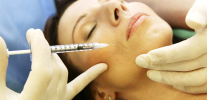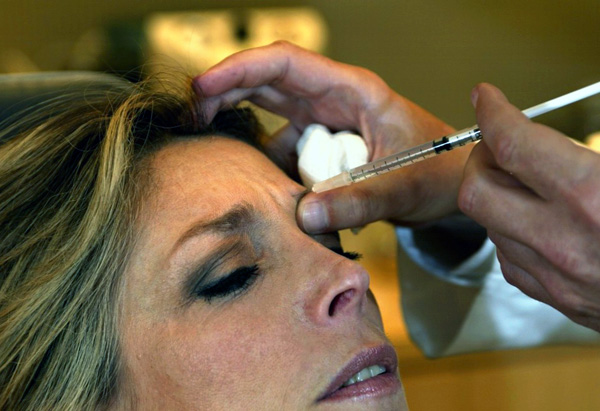
More than a third of all botulinum therapy procedures are Botox injections or similar drugs on the forehead. Injections into this area are carried out more often than in any other part of the face or body, simply because wrinkles are formed earlier than anywhere else - the forehead is actively involved in expressing emotions, the frontal muscle is constantly involved in the process of raising the eyebrows, and, as a result, already at a relatively young age horizontal wrinkles form on the skin here.
The effect is further enhanced by the high visibility of these skin folds. If in some other places (for example, in the corners of the eyes), wrinkles are small and visually smoothed by eyelashes, eyes and sometimes hair, then the forehead occupies most of the face and any skin defects here are literally striking. For this reason, wrinkles on the forehead often require action even earlier than the classic “interlinear” for Botox.
Here, we will immediately agree to continue talking specifically about Botox injections in the forehead, and not in the upper part of the face in general. Traditionally, many patients view an eyebrow wrinkle as related to frontal defects. At the same time, the injection of both the forehead and the nose, which is considered classic, reinforces this well-established view - as a rule, if the crease appears between the eyebrows, then there is already something to be done on the forehead. As a result, doctors usually chop both the eyebrow and the entire forehead.
However, here we will only talk about the forehead, wrinkles on it and Botox injections into the frontal muscles.
By the way, we will discuss not only Botox, but also other botulinum toxin preparations due to their similar action and generally identical application. Given that the word “Botox” is more often understood to mean any drug of botulinum toxin, and not just a specific product of Allergan Corporation, this will be entirely justified.
So, when you need to inject Botox in the forehead, what cosmetic effects can be achieved by such procedures as they are carried out and what consequences can these injections lead to?
The principle of Botox in the removal of wrinkles on the forehead
Botox, like any other botulinum toxin drug, does not directly affect the wrinkles themselves. He does not fill them, as fillers do, he does not stretch and smooth the skin, which is characteristic of peels and reinforcing threads. The principle of its action is different: the drug denervates the muscles, the contraction of which leads to crushing of the skin and the formation of creases on it. Since the position of these muscles and the places of formation of folds are constant, wrinkles are formed in these places on the skin, at first subtle, but gradually becoming deeper.
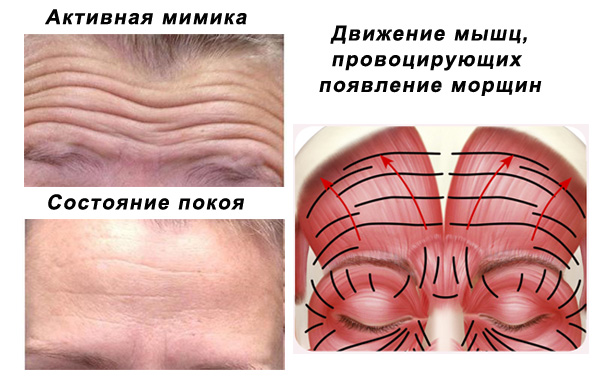
Muscles, the active work of which provokes the appearance of wrinkles on the forehead, are deactivated by botulinum toxin preparations.
If the muscles, whose activity leads to skin tightening, relax and do not contract for a long time, such folds do not occur and wrinkles gradually either disappear on their own due to the regeneration of skin cells, or are smoothed out using additional cosmetic procedures.
Muscle relaxation is due to the main effect of botulinum toxin: it disrupts the transmission of nerve impulses in the neuromuscular synapses - the contact points of nerve endings with muscle cells. It is here, at the synapses, that the incoming nerve impulse stimulates the release of acetylcholine, which in turn causes the muscle fiber to contract. When botulinum toxin enters the synapse, acetylcholine ceases to be released here and the muscle does not contract regardless of the activity of the neurons that innervate it.
Particularly noteworthy in this case is that after the injection of botulinum toxin, the forehead does not wrinkle neither with involuntary muscle contractions, nor even with human attempts to do it intentionally. Some undesirable effects of botulinum therapy are associated with this, which will be discussed below.
On a note
According to the same principle, botulinum toxin, falling into the bloodstream during poisoning, leads to death: it disrupts the innervation of the vital muscles of the body, for example, the heart muscle or diaphragm. As a result, a person poisoned with botulinum toxin dies either from cardiac arrest or from suffocation. Cosmetic use of botulinum toxin is almost completely safe due to the fact that botulinum toxin does not penetrate into the bloodstream and does not affect vital muscles, and due to the fact that it is introduced into the frontal muscles in very small quantities, which can not lead to poisoning.
As a result, a person’s forehead after botulinum toxin injections simply ceases to frown. Whether already formed wrinkles disappear after this depends on the age, skin features and depth of the wrinkles themselves.
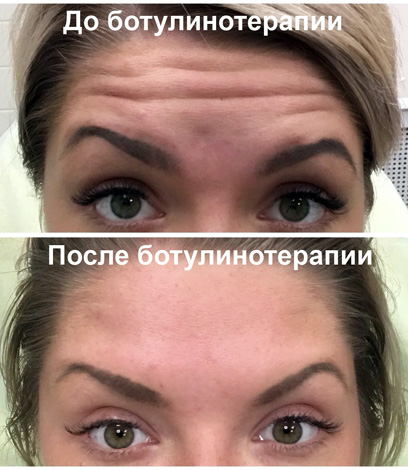
Injections of botulinum toxin into the forehead relieve muscle hypertonicity.
Usually, in women who catch up because of “stripes on the forehead” at 30-35 years old, after Botox injections, wrinkles disappear without additional procedures after a few weeks due to the natural elasticity of still quite young skin. In older patients, deep old wrinkles by themselves are not smoothed, even though there is no wrinkling of the skin. After Botox injections, they need to be eliminated by additional procedures - peeling, biorevitalization, various types of lifting.
Feedback
The first time I decided to inject Botox in the forehead at the age of 30. There was nothing, wrinkles had not yet formed, she did so that they did not arise. I was afraid then, because everyone was frightened that Botox was very dangerous for health, it was not enough to inject it for a short while, and if it somehow didn’t work, then it could not be neutralized. Well, in general, I realized - if there is so much negativity, it’s definitely worth a try) I did not regret it. The effect is wonderful - the forehead is smooth, no stripes, no bumps. At the same time, natural facial expressions are preserved, that is, you can even frown. I have enough for a long time - at first for 10 months, then somewhere for 7-8. Now I do it once a year, but because of this month 3-4 wrinkles are already visible, although not directly obvious, you can walk with them. Plus there was a big break for two years, while giving birth, pregnant Botox is harmful. It rises normally, once there was a swelling, but basically no side effects appear. The main thing I was afraid of was that there was no mask effect, it was not at all visible that Botox was injected into the forehead. I saw women who were pierced with fillers - this is really scary when the forehead hangs, cones stick out directly at the temples. From Botox this does not happen in principle, so for now I am only for him.
Julia, Nizhny Novgorod
Botox's action is temporary. This is due to the fact that the body recognizes such a chemical denervation as a kind of violation and independently fights it. As a result, over several months, new synapses are formed on the processes of the nerve cell in contact with muscle fibers, but free of botulinum toxin. They start the normal transmission of nerve impulses, leading to the resumption of muscle activity. After this, muscle contraction again begins to wrinkle the skin and wrinkles.
How effective and for how long do botulinum toxin preparations smooth frontal wrinkles?
With a competent professional introduction of Botox into the forehead, the causes of dynamic wrinkles - the deepest and most noticeable ones - can be completely eliminated. As a result, after the procedure on relatively young skin, the folds completely disappear themselves, and in older people the same effect will be achieved after additional measures.
In the photo below, you can evaluate the result of Botox injections in the forehead:

It can be seen that before the procedure, wrinkles were very pronounced, and after botulinum therapy they completely disappeared.
In addition to eliminating wrinkles, Botox allows you to slightly "raise" the forehead, eliminate the asymmetry of the location of the eyebrows, remove dermatochalasis (skin hanging over the eyelid).
The result of the introduction of botulinum toxin is visible within a day or two after the procedure. This period may vary slightly among different people depending on their susceptibility and the presence of side effects, but the maximum time for the manifestation of the effect is 5-7 days after the procedure. If after this period there is no result, conclude that the patient is immune to botulinum toxin.
It is noteworthy that in people under 40-45 years of age Botox leads to smoothing the skin so effectively that their forehead begins to literally shine in the light. This, incidentally, is also striking and may seem unusual.
The already developed effect lasts up to 6-8 months, after which the wrinkles gradually reappear. Statistics show that due to the high mobility and large area of the frontal muscle, its activity is restored somewhat faster than, for example, the activity of individual fibers of the circular muscle of the eye. For this reason, to permanently maintain the effect, Botox should be stabbed in the forehead regularly.
There is an assumption that the more injections into the forehead were performed, the more often the subsequent procedures would have to be repeated. Theoretically, this can be justified by the mechanisms of adaptation of the body to botulinum toxin, but in fact there is no evidence to support this hypothesis.
By the way, about immunity: according to statistics, in 5-8% of patients, the effect of botulinum toxin is not manifested at all. This is most often associated with the existing immunity - if a person has previously encountered this substance in his life (for example, had botulism) and he developed mechanisms to neutralize the poison. In such patients, injections of any botulinum toxin preparations such as Botox, Dysport, Xeomin and the like will be equally ineffective.
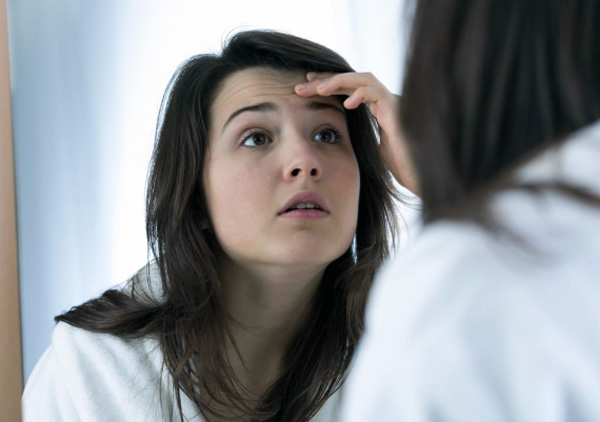
There is a category of patients on whom botulinum toxin injections do not work, so the result from the procedure will be practically zero.
In any case, Botox can effectively eliminate only dynamic wrinkles. It is either impossible to remove other cosmetic defects with its help in principle, or the effect of the product will be limited.
For example, Botox will not work to remove age spots, bumps, or, conversely, dents, especially age-related, associated with thinning of the skin. The proper use of botulinum toxin preparations to some extent allows you to reduce the visibility of fresh scars and scars, but it will not help to completely hide them.
Procedure
The procedure for botulinum treatment of the forehead muscles is usually carried out quickly enough and takes no more than an hour. In most cases, it is combined with injections into the interbrow fold, sometimes with botulinum therapy of other parts of the face.
Directly before the procedure, the doctor conducts a thorough diagnosis, during which he:
- He asks the patient to depict certain emotions (smile, frown, sardonically raise an eyebrow), strain different muscles of the face. This will allow not only to assess the depth and degree of “neglect” of wrinkles, but also to find the individual anatomical features of the patient’s face, so that in the future, Botox can be correctly pricked into the right fibers, at the right depth and in the right quantities;
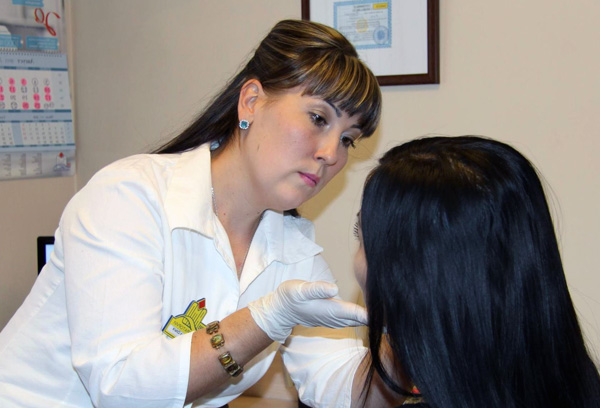
Before the procedure, the doctor carefully examines the patient's face in order to subsequently achieve the maximum effect.
- He studies the anamnesis, evaluates the presence or absence of contraindications;
- Issues a special agreement for botulinum therapy for signing, in which the patient confirms in writing that he is aware of the possible risks of side effects of the procedure.
Also, the doctor must make sure that the patient came to the procedure properly prepared. Before the procedure, you cannot take certain types of drugs - muscle relaxants, antidepressants, antispasmodics, tonic, antibiotics. It is extremely undesirable on the day of the procedure to drink alcohol and play sports. All this can affect muscle activity, the accuracy of diagnosis and, ultimately, the result of the procedure.
After diagnosis, the doctor selects the point of administration and the amount of the drug.
Choosing injection points, the cosmetologist must first evaluate which muscles cause wrinkling of the skin, how the fibers of these muscles are located, how much they contract in the patient. In the ideal case, muscle fibers should be denervated pointwise, so as to eliminate forehead wrinkling, but to maintain the severity of emotions on it.
On a note
Beginners and inexperienced cosmetologists often make injections at the “points” - universal schemes used to obtain one or another result. Obviously, such schemes can always be only guidelines, since both the forehead and the location of muscle fibers under the skin on it are very individual. Work on “universal” schemes is fraught with various complications, since the location of the points of administration of the drug in each person will be more or less specific.
Before the introduction of the drug, the doctor restores the solution by adding a solvent to the powder bottle. Then, the right amount of the drug is taken from the vial with a syringe with a very thin cosmetology needle and the doctor proceeds to injections.
The skin at the site of each injection is rubbed with an analgesic (lidocaine or its equivalent), is captured by the index and thumb at a distance of 1-1.5 cm and is slightly compressed. A needle is inserted into the formed roller to the desired depth and the doctor squeezes the required amount of the drug. Then he unclenches his fingers and within a few seconds easily massages the skin at the injection site. After that, an injection is made at the next point.

To make an injection, the doctor grabs the skin and injects the required amount of the drug into the resulting roller.
In general, the introduction of the drug usually lasts 10-15 minutes and is carried out in a seated chair with a slightly reclined back. Upon completion of the injection, the patient remains in the chair for another 10-20 minutes for medical supervision. This is necessary in case of a possible occurrence of an allergic reaction - it is allergies that pose the greatest danger to patients, and when their signs appear, the doctor quickly uses stopping drugs. If there is no allergy at this time, the beautician can give the patient recommendations for the prevention of possible side effects.
Place of introduction and amount of applied means
In most cases, Botox is injected into the forehead at 4-6 points - two at different heights on the sides and two in the center of the forehead. With very strong muscle contractions and deep wrinkles, the number of points can be increased to 12 (they are evenly distributed over the entire width of the forehead), and with a weak severity of creases - reduced to 2.
The injection points of the drug should not be lower than 1 cm from the edge of the orbit. It is advisable that they are 2-3 cm higher - this reduces the risk of ptosis after injection.
The doctor chooses the amount of the drug based on the results of the diagnosis and the specifics of the drug itself. For example, 1 unit of Botox and its analogues is approximately equivalent in terms of the severity of the resulting effect to 2-3 units of Disport.
Many doctors recommend that Botox does not remove the lower frontal wrinkle. Injections near it are fraught with ptosis, and practice shows that the correct use of a filler here can effectively smooth it.
Most often, 8-20 Botox units in women and up to 30 units in men are injected into the forehead area.
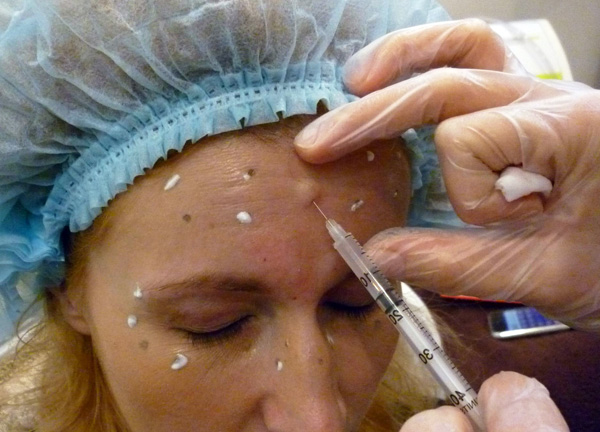
As a rule, a woman needs from 8 to 20 units of Botox in the forehead (depending on age, skin condition and wrinkle depth).
Practice shows that the amount of botulinum toxin used is weakly affected by the duration of the effect.Rather, the amount of drug administered affects the size of the forehead on which the result is manifested. If the wrinkles are very deep and long, you have to take large amounts of the drug to eliminate them along the entire length. If they are relatively small, it is enough to immobilize the muscles in the central part of these wrinkles, and their corners will then be smoothed out on their own.
Therefore, if Botox is given to a specific patient for the first time, then they try to introduce the minimum dose, and if necessary, give additional injections after a few weeks. It is safer than injecting an excessive amount of the drug at once with the risk of side effects.
Security details: possible contraindications and side effects
In general, Botox injections into the forehead are considered a fairly safe procedure. The number of various undesirable effects after botulinum therapy, correlated with the number of injections in general, is very small, and the complications themselves are usually relatively mild and quickly disappear.
There are even cases when former clinic patients inject each other Botox on their own, as part of the usual "home" cosmetology procedure - just like painting nails or twisting hair.
Nevertheless, due to the large number of ongoing botulinum therapy procedures, in general, side effects occur quite often. Sometimes they develop for objective reasons, in other cases they arise due to the mistakes of the doctor or are the result of a violation of the rehabilitation regimen by the patient.
Most often, undesirable effects develop due to the reaction of tissues to a botulinum toxin preparation. These include, for example:
- Edema and bumps on the forehead at the injection sites - usually go away on the third or fourth day;
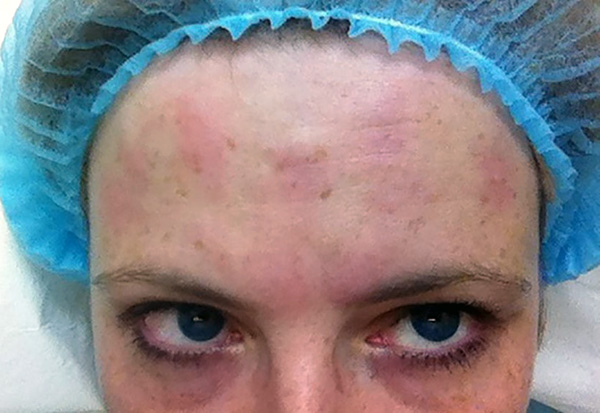
Traces of injections, swelling and redness, as a rule, disappear within a few days.
- Pain and itching at the injection site - pass quickly, already during the first day;
- Foreign body sensation, heaviness under the skin of the forehead;
- Headache, respiratory syndrome - usually last 2-3 days after injections;
- Rash, acne (sometimes with suppuration) in the injection zone.
All these manifestations are temporary and do not last long. Nevertheless, many patients who count on literally instant action of the drug often manage to panic if the next day after the procedure they find not a smooth forehead, but swelling or ugly tubercles at the injection site. Of course, in 3-4 days all these consequences will disappear and the forehead will become exactly what the woman dreamed of, but in these three days she will probably have time to write some negative reviews on all the forums and sites known to her, and it’s precisely these reviews that make other patients in the future they will form their opinion on the procedure itself.
To reduce the risk of undesirable consequences, injecting Botox in the forehead should only be in the absence of contraindications. Such contraindications include:
- The presence of infectious rashes on the forehead;
- The acute stage of any infectious disease (including influenza and other acute respiratory viral infections);
- Pregnancy and lactation;
- An acute allergy to any allergen or known intolerance to botulinum toxin;
- The tendency of the skin to keloid scarring;
- Oncological diseases;
- Taking certain medications.
The consequences of introducing Botox into the forehead in the presence of such contraindications are unpredictable, and in some cases (for example, intolerance) can be deadly.
Due to the risk of side effects and complications, it is not recommended to inject Botox “for the sake of experiment”, for example, at a very young age (up to 30 years), when even women with very expressive facial expressions and already formed frontal wrinkles are easier and safer to mask them with cosmetics than to stab Botox.On the other hand, it is also undesirable for very elderly people with deep wrinkles to undergo botulinum therapy - this procedure will not help to radically affect their appearance, but they can cause unpredictable effects.
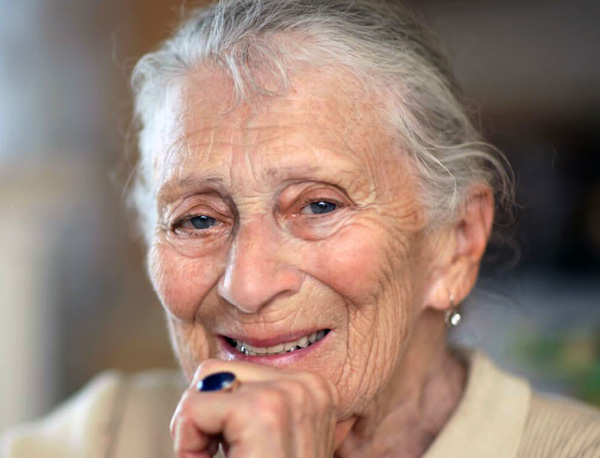
It is not recommended to inject Botox into women at a sufficiently mature age, since it is already almost impossible to correct deep age changes with such injections.
Possible negative consequences for errors on the part of the doctor and patient
When Botox injections into the forehead, the most undesirable side effects are those that persist for the entire duration of the drug. It can be:
- Noticeable violations of natural facial expressions. The effect of botulinum therapy itself is always a certain change in the complex of facial expressions, but negative consequences include those that are very striking and ruin the appearance. An extreme case of such disorders is the so-called “mask on the forehead”, when due to complete immobilization of the muscles, the skin on the forehead does not move at all under any emotions;
- Mimic defects - raising eyebrows, symmetrical or uneven, and more often - on the contrary, dropping them and the appearance of an expression of fatigue on the face;
- The increase and protrusion of the eyebrows - develops due to the fact that the entire function of keeping the eyes open is shifted to the muscle fibers located at the level of the eyebrows. These muscles quickly increase in size, become firmer, the so-called “roller” is formed, giving the face the features of masculinity and aggressiveness;
- Ptosis is the omission of the eyelid with partial or complete closure of the eye.
These consequences are rare and mostly associated with errors and lack of professionalism of a doctor who injects either too large doses of the drug or chops off non-target muscles. All of them are due to the main action of Botox and therefore persist for about as long as the target effect of using this tool. Since it is impossible to physically remove Botox from the forehead muscles, when such effects appear, compensating procedures are carried out that help to quickly get rid of undesirable consequences, and together with them the result of the action of Botox itself.
The same effects are manifested in violation of the rehabilitation regime after botulinum therapy. For example, after injections, you can’t take a horizontal position and sleep for several hours, you can not play sports and drink alcohol, undergo other cosmetic procedures, bathe in hot water and stay in the sun for a long time. Violation of these rules can lead to the fact that the drug diffuses into non-target muscles and causes them to immobilize.
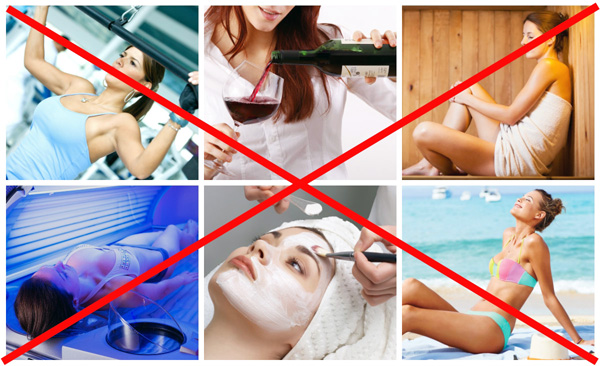
After the botulinum treatment procedure, one should strictly adhere to the doctor's recommendations.
Feedback
I decided for myself - Botox is only in the forehead and between the eyebrows. Never touch the crow's feet! There is a very unpleasant experience, well, not mine. Pricked sister: forehead, interbrow, edges of eyes. So, everything seems to be fine, the head does not hurt, does not affect vision, there are no horrors from other people's reviews. But only until she smiles. Smiles - that's it, atas. Lips blur in a smile, but eyes and forehead do not move, nothing pulls them on the side and below. It makes a terrible impression, as if a person is not alive. I didn’t tell my sister, but she, apparently, saw everything herself. Well, she managed to quickly get everything out, Botox is quickly neutralized with an accelerated metabolism. She herself is like that, plus an athlete, with intensive training and preparation for training, they have the Botox effect in 1-2 months, even one girl in three weeks finished acting, she had to be downloaded again in the same month. In general, she drove herself and pretty quickly everything returned to normal. But now I know for sure that it’s better for Botox to cut off only the forehead and the interlinear eye, and only a good doctor should do this so that the dosage is very clearly selected.
Lily, Moscow
Compared to these effects, the effects of Botox's insufficient dosages seem less critical. Typically, in such cases, incomplete removal of wrinkles occurs, and it is quite simple to “pierce” the forehead in a few weeks.
Separately, it should be said about the possible consequences of injections of fake botulinum toxin preparations. They can be very diverse - from relatively harmless (for example, simply the lack of effect) to very dangerous (severe allergies, rejection of the drug, the formation of noticeable scars), and in many cases the doctor may not even suspect that he is not an original drug, because He doesn’t answer the purchases at the clinic. This is another reason not to chase the low price of the procedure, but to choose a doctor first of all based on reputation and reviews.
A few words about the cost of the procedure
The cost of Botox injections depends primarily on the amount of drug that will be administered during the entire procedure, and secondly, on the prestige of the clinic.
As a rule, the price of injections is calculated per 1 unit. On average, in Moscow, a procedure costs 300-350 rubles per unit for Botox and 180-220 rubles for Dysport.
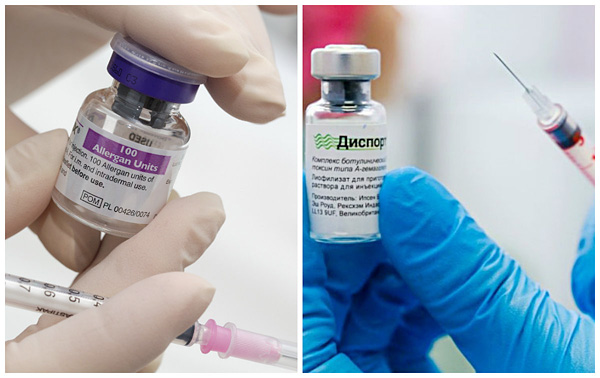
On average, in the capital, 1 unit of Botox costs 300-350 rubles, and Disport - 180-220 rubles.
Botulinum botulinum therapy with Relatox as a Russian drug is somewhat cheaper than Botox injections (280-310 rubles with the same amounts as for Botox), but it is after its administration that the forehead hurts most often, and the injections themselves are rather painful. Whether these troubles are worth the savings that the drug provides is an open question.
In regions, the cost of the procedure may be lower - 270-300 rubles for Botox and 150-180 rubles for Disport.
The total cost of injections of funds in the forehead ranges from 3000-7000 rubles for the procedure with Botox and 2500-4500 rubles for the procedure with Dysport.
In general, Botox is considered the “gold standard” for botulinum toxin therapy. Doctors know him well, most of them have good experience in its use, which ensures high safety procedures with him. Partly for this security you have to pay a slightly higher price.
Approximately the same safety is typical for Dysport and Xeomin - also quite well-known and long familiar to cosmetologists drugs. Other means, including various novelties, often turn out to be cheaper (it is precisely because of this that their manufacturers are trying to win their place in the market), but with this cheapness, patients are paid for possible unforeseen consequences.
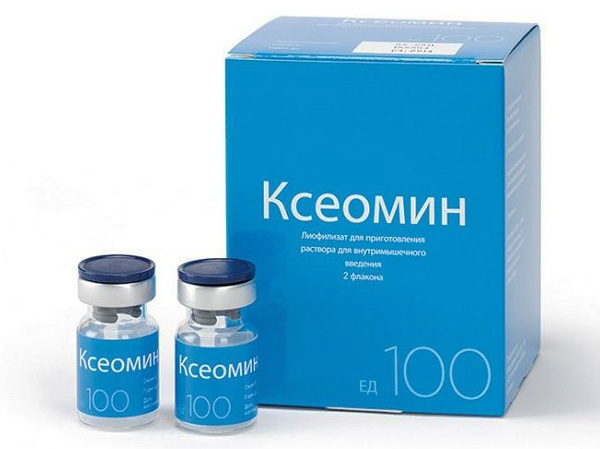
Xeomin, like Dysport, is an analogue of Botox.
Possible alternatives to Botox for forehead wrinkle correction
It is important to remember that in many cases Botox is not the best way to remove cosmetic defects on the forehead. And sometimes it won’t help at all, and completely different methods will have to be used to smooth out wrinkles.
For example, if there are contraindications to botulinum to clear wrinkles, you definitely need to choose other paths. At a relatively young age (up to 50 years) it is not particularly difficult - even dynamic wrinkles can be removed or substantially smoothed with other drugs. Later, these same funds will still be necessary due to aging of the skin - a paralyzing muscle alone will not be enough effect.
As a rule, the main alternative to Botox and its analogues are fillers. Some of them work as a filler, simply filling the tissue under the "creases" of the skin and reducing the severity of wrinkles.

The most popular fillers based on hyaluronic acid. With their help, you can reduce the depth of the frontal valleys.
Their plus is that they do not violate the natural facial expressions. Their disadvantages are incomplete elimination of wrinkles and a high risk of extremely unsightly effects. All those scary photos with women disfigured by plastic surgeons just show errors in the use of fillers, because of which the face literally swells, being filled with neutral fillers.
Other fillers work on a different principle: they stimulate the production of normal components of the dermis and the restoration of its structure. So the effect of biorevitalization is manifested. Using them alone, wrinkles cannot be quickly and completely removed, but they can effectively supplement the action of Botox in people older than 40, whose skin begins to age.
If wrinkles in a person are shallow, you can get rid of them with the help of various peels, mesothreads, thermal lifting. Nevertheless, there are not so many obvious advantages of these procedures over botulinum therapy: their price is approximately the same (and sometimes higher), and side effects can be even more unpleasant.
All this means that the doctor who can assess the possibilities of cosmetic correction of the forehead and the safety of each specific procedure must choose both the wrinkle removal method itself and the drug for botulinum therapy (if the choice is stopped on it). It is precisely such a cosmetologist whose opinion you can trust, and you need to look for, and then trust him and get the desired effect on the forehead, for which all this was organized.
Useful video about Botox injections: indications and contraindications to them, as well as stages of the procedure
Patient recall after Botox injections in the forehead


